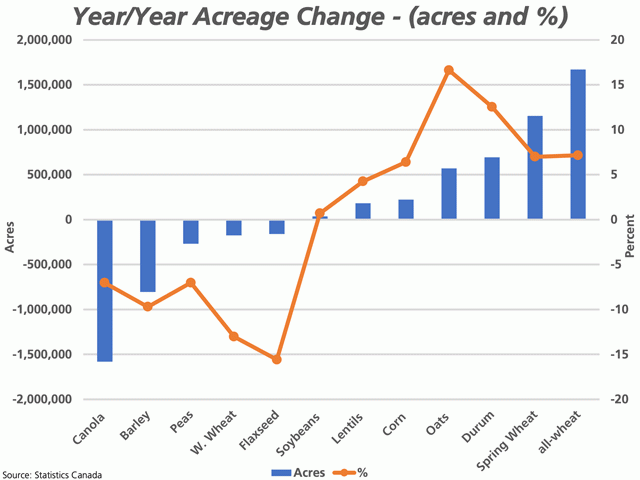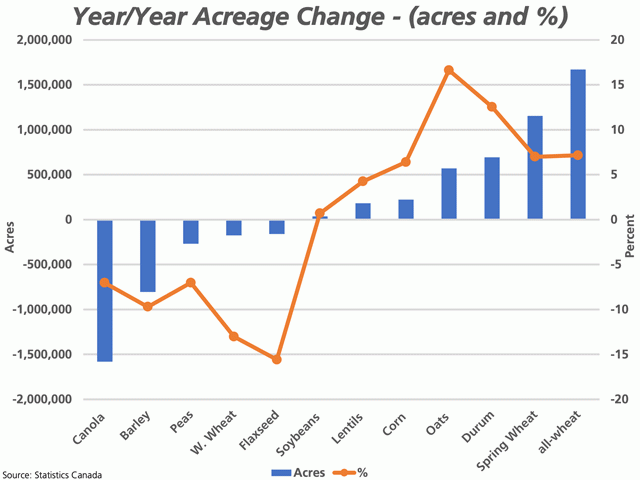Canada Markets
Statistics Canada Estimates Acres, Canada Responds With More Wheat
The April 26 Statistics Canada Principal Field Crop Areas, March 2022 release is the first official release for the 2022-23 crop year. Today's release was based on the March 1-31 survey of 11,500 producers from the five provinces including Alberta, Saskatchewan, Manitoba, Ontario and Quebec.
There are a number of reasons why this report may be focused on more than normal, including:
-- Canada's 2021-22 grain stocks may be approaching all-time lows, with stocks of crops such as barley and oats already forecast at levels that will reach all-time lows.
-- There are attractive potential returns and demand potential across a wide number of crops.
-- Input costs remain high and may have a detrimental effect on seeded acres for some crops.
-- Soil moisture conditions vary widely, with ongoing drought conditions seen for the southwestern Prairies while the eastern Prairies face excessive precipitation that has taken place since the March surveys were conducted.
-- World markets continue to recover from the global pandemic disruptions while the Russia-Ukraine war during the past two months has added to global food security concerns and has led to protectionist measures taken by some exporters.
P[L1] D[0x0] M[300x250] OOP[F] ADUNIT[] T[]
Statistics Canada sums up the entire report by stating that producers plan to seed more wheat, corn, lentils, soybeans and oats, while seeding fewer acres of canola, barley and peas.
The attached chart highlights this shift in acres, with the blue bars highlighting the largest year-over-year acreage reductions seen for canola and barley, while the largest increases are seen for spring wheat and durum.
Statistics Canada has estimated Canada's all-wheat acres, including winter wheat remaining, at 25.031 million acres, up 7.2% from last year and 4.1% higher than the five-year average. This would be the largest acres seeded in nine years, or since 2013. Behind this increase is an increase in both spring wheat and durum acres, while winter wheat acres are to fall from 2021. The largest reported change is a 10.6% all-wheat increase in Saskatchewan. The all-wheat estimate is higher than the upper end of the range of pre-report estimates that ranged from 22.9 million acres to 24.85 million acres.
Spring wheat acres on the Prairies are estimated at 17.634 million acres, up 1.153 million acres or 7% from 2021, while 2.2% higher than the five-year average. Since 2002, or the past 20 years, spring wheat acres have trended mostly sideways, ranging from a low of 15.1 million acres to a high of 19 million acres, with the 2022 estimate in the upper one-half or the range. The largest increase is forecast for Saskatchewan with a 10.6% increase, which compares to 6.3% in Alberta and 5.7% in Manitoba. At the time of writing, spring wheat futures are poised for a higher close but new crop contracts have seen overnight gains pared. Despite the higher acres, the market focus may remain on the slow start to planting in the U.S.
Statistics Canada had previously estimated acres planted to winter wheat last fall at 1.352 million acres, down 6.7% from the previous year, largely due to lower acres planted in Ontario because of the late harvest. Today's report estimated winter wheat acres remaining at 1.1729 million acres, down 13% from the previous year for the smallest winter wheat acres in three years. The loss of acres during the winter is estimated at 178,700 acres, slightly below the five-year average of 208,280 acres.
Durum acres had been forecast to rise year-over-year, but today's report surprised to the upside, with acres estimated at 6.224 million acres, up 12.5% from last year and 13.2% higher than the five-year average. This is above the range of pre-report estimates ranging from 5.5 million acres to 6.05 million acres while would be the largest area planted since 2000, or 22 years. AAFC's supply and demand estimates had already pointed to a 100% increase in durum stocks during the crop year ahead, while this larger area would add to that carryout, bearish for prices. At the same time, excessive rains in the eastern Prairies during April may curtail some of these acres.
Today's canola estimate may be viewed as a surprise, with acres set to fall more than expected. According to Statistic Canada, acres are set to fall by 7% or close to 1.6 million acres to 20.897 million acres, down 5.2% from the five-year average. This is below the range of pre-report estimates that expected acres to fall to a range from 21.6 million acres to 22.75 million acres, while AAFC had previously estimated a 3.2% drop to 21.745 million acres. Year-over-year drops of this magnitude are not unheard of, but not common. During the past 20 years, there was a 1.6-million-acre drop in 2019 and a 1.7-million-acre drop in 2013. AAFC's more modest drop in acres was forecast to lead to a modest 200,000-metric-ton increase in 2022-23 stocks, based on an average crop and demand assumptions made, while the drop in acres forecast by Statistics Canada would make a recovery in stocks difficult. November canola reached a fresh contract high overnight, while today's gains were extended following the report release, having traded over $1,100/metric ton for the first time ever for a November contract.
Statistics Canada has estimated barley acres at 7.491 million acres, down 9.7% from 2021 and 5.2% below the five-year average. This is below the lower end of the range of pre-report estimates ranging from 7.8 million acres to 8.5 million acres, while well below the 8.2 million acres forecast by AAFC. AAFC's forecast that included a more modest cut in acres and a return to average production pointed to a sharp rise in stocks in 2022-23 to 1 million metric tons from this year's historic low of 300,000 mt, although today's lower acres could make that a challenge. At the same time, late planting in the eastern Prairies could see a late swing to barley.
Of all major crops, the largest percentage increase in acres is seen for oats, with acres to increase by 569,100 acres or 16.6% to 3.992 million acres, 16.7% higher than the five-year average. This would result in the largest area seeded to oats since 2008 or 14 years, with this area coming in at the upper end of the range of pre-report estimates. AAFC had previously factored in a 3.7-million-acre crop, leading to a year-over-year increase in stocks, which suggests that today's report is increasingly bearish based on prospects of an average crop.
Producers are forecast to increase planted acres of lentils to 4.486 million acres, up 4.2% from last year and 9.5% higher than the five-year average. This would be the largest crop seeded since 2016 or six years, while this area is slightly higher than the upper end of the range of pre-report estimates from 4.2 million acres to 4.45 million acres. Given AAFC's forecast for 2022-23, stocks are forecast to rise year-over-year based on assumptions made.
Dry pea acres are forecast to fall unexpectedly, down 7% to 3.551 million acres, while 11.7% below the five-year average. This would be the smallest dry pea crop since 2013, or nine years. AAFC had forecast a 6.7% increase in acres to 4.1 million acres, which was forecast to result in a year-over-year rise in stocks. This forecast would result in continued tight stocks but will continue to be debated to the lower nitrogen requirement for the crop and reduced input costs involved.
Statistics Canada row crop estimates will also be debated. Today's forecast included a 0.7% increase in soybean acres and a 6.4% increase in corn acres. One clue may exist in the forecast prices for the 2022-23 crop year, with AAFC forecasting the average corn price to fall by $15/mt and soybean prices to fall by $50/mt. On March 31, the USDA forecast a 4% drop in corn acres combined with a 4% rise in soybean acres.
Corn acres are forecast to rise to 3.715 million acres, up 3.5% from the five-year average. This is above the range of pre-report estimates that called for acres to fall within the 3.2 million acres-to-3.5 million acres range. This would be a record corn area by a slim margin, largely due to an 8.2% increase in Ontario to 2.3 million acres, or 62.5% of the nation's total acres. Increases are also expected for Quebec (24%) and Manitoba (11.6%), with the percent of the country's total acres in brackets.
Canada's soybean area is forecast to rise by a modest 0.7% or 36,700 acres to 5.358 million acres, which would be the largest area seen in three years, while falling closer to the lower end of pre-report estimates. Acres are forecast to fall in Quebec, Manitoba and Saskatchewan, while are forecast to rise by 93,500 acres or 3.2% in Ontario, where a forecast 56.6% of the country's acres are seeded.
Cliff Jamieson can be reached at cliff.jamieson@dtn.com
Follow him on Twitter @Cliff Jamieson
(c) Copyright 2022 DTN, LLC. All rights reserved.






Comments
To comment, please Log In or Join our Community .